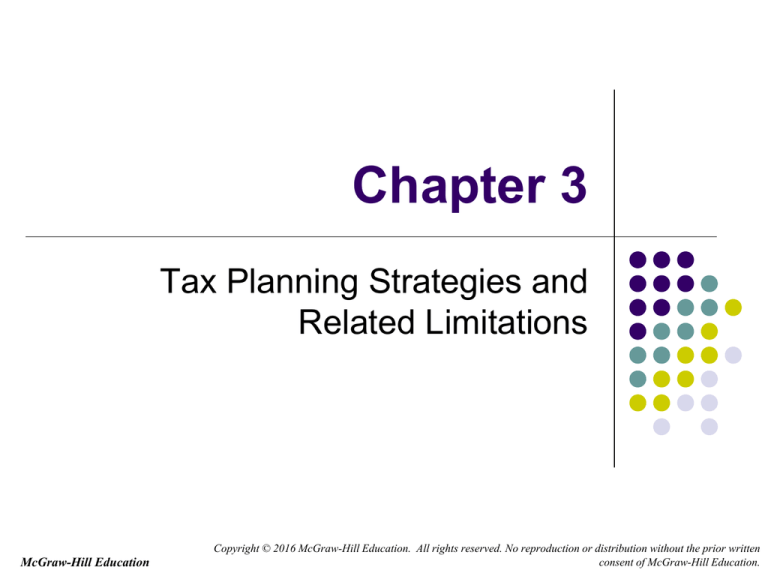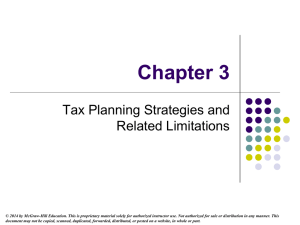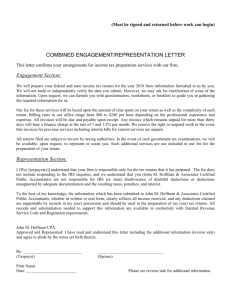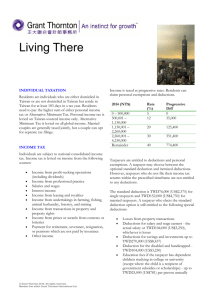
Chapter 3
Tax Planning Strategies and
Related Limitations
McGraw-Hill Education
Copyright © 2016 McGraw-Hill Education. All rights reserved. No reproduction or distribution without the prior written
consent of McGraw-Hill Education.
Learning Objectives
Identify the objectives of basic tax planning
strategies.
Apply the timing strategy and describe its
applications and limitations.
Apply the concept of present value to tax
planning.
Apply the strategy of income shifting,
provide examples, and describe its
limitations.
Learning Objectives (Cont.)
Apply the conversion strategy, provide
examples, and describe its limitations.
Describe basic judicial doctrines that
limit tax planning strategies.
Contrast tax avoidance and tax evasion
Basic Tax Planning Overview
Effective planning requires consideration for
both tax and non-tax factors
In general terms, effective tax planning
maximizes the taxpayer’s after-tax wealth
while achieving the taxpayer’s non-tax goals
3 parties to every transaction: taxpayer,
other party, and the government
3 basic planning strategies: timing, income
shifting, and conversion
Timing Strategies
When income is taxed or an expense is
deducted affects the associated “real” tax
costs or savings for 2 reasons
(1) the time that income is taxed or an expense is
deducted affects the present value of the taxes
paid on income or the tax savings on deductions.
(2) the tax costs of income and tax savings
income vary as tax rates change
Timing Strategies
The concept of Present Value.
$1 today is worth more than $1 in the future.
The implication of the time value of money for tax
planning is that the timing of a cash inflow or a cash
outflow affects the present value of the income or
expense
When considering cash inflows, higher present
values are preferred; when considering cash
outflows, lower present values are preferred
Timing Strategies
Present Value = Future Value / (1 + r)n
Exhibit 3-1 provides the discount rates for a
lump sum (single payment) received in n
periods using various rates of return
Timing Strategies – Present
Value Example
At a recent holiday sale, Bill and Mercedes purchase
$1,000 worth of furniture with “no money down and
no payments for one year!” How much money is
this deal really worth? (Assume their after-tax rate
of return on investments is 10%.)
The discount rate of .909 (Exhibit 3-1, 10% interest
rate column, year 1 row) means the present value of
$1,000 is $909 ($1,000 x .909 = $909)— so Bill and
Mercedes save $91 ($1,000 - $909 = $91).
Timing Strategies
Two basic tax-related timing strategies:
Accelerating deductions
Essentially accelerating a current cash inflow
Deferring income
Essentially deferring a current cash outflow
Timing Strategies Example
Mercedes, a calendar year taxpayer, uses the cashbasis method of accounting for her small business.
On December 28th, she receives a $10,000 bill from
her accountant for consulting services related to her
small business. She can avoid late payment
charges by paying the $10,000 bill before January
10th of next year. Assume that Mercedes’ marginal
tax rate is 30% this year and next and that she can
earn an after-tax rate of return of 10% on her
investments. When should she pay the $10,000
bill – this year or next?
Timing Strategies Example
Mercedes should pay the bill this year
Present value tax savings if pay this year:
$10,000 x 30% = $3,000
Present value tax savings if pay next year:
$10,000 x 30% x .909 = $2,727
Timing Strategies When Tax
Rates Change
When tax rates are increasing, the taxpayer
must calculate the optimal tax strategies for
deductions and income. Why?
The taxpayer must calculate whether the benefit
of accelerating deductions outweighs the
disadvantage of recognizing deductions in a lower
tax rate year.
The taxpayer must calculate whether the benefit
of deferring income outweighs the disadvantage
of recognizing income in a higher tax rate year.
Timing Strategies When Tax
Rates Change
When tax rates are decreasing, taxpayers
should accelerate tax deductions into earlier
years and defer taxable income to later years.
Why?
Accelerating deductions maximizes the present
value of tax savings from deductions due to the
acceleration of the deductions into earlier years
with a higher tax rate year.
Deferring income minimizes the present value of
taxes paid due to the deferral of the income to
later years with a lower tax rate.
Tax Rate Change
Having decided she needs new equipment for her
business, Mercedes is now considering whether to
make the purchase and take a corresponding
$10,000 deduction at year end or next year.
Mercedes anticipates that, with the new machinery,
her business income will rise such that her marginal
rate will increase from 20% this year to 28% next
year. Assuming her after-tax rate of return is 8%,
what should Mercedes do?
Tax Rate Change Solution
Mercedes should pay the $10,000 in January
Tax savings in paid in December
$10,000 x 20% = $2,000
Tax savings in paid in January
$10,000 x 28% = $2,800
Discount savings back to current year
2,800 * .826 = $2,593
Limitations of Timing
Strategies
The tax deduction often cannot be accelerated without
the actual cash outflow that generates the deduction
Tax law generally requires taxpayers to continue their
investment to defer income
Deferral strategy may not be optimal if taxpayer has
cash flow needs, or if continuing investment generates
low returns or subjects taxpayer to unnecessary risk
Constructive receipt doctrine: taxpayer must
recognize income when it is actually or constructively
received
Income Shifting Strategies
Income shifting exploits the differences in tax rates
across taxpayers by shifting income from high-tax rate
taxpayers (jurisdictions) to low-tax rate taxpayers
(jurisdictions) or shifting deductions from low-tax rate
taxpayers (jurisdictions) to high-tax rate taxpayers
(jurisdictions)
Transactions between family members
Children generally have lower marginal tax rates and
therefore, parents may shift income to children so it will be
taxed at the child’s tax rate
Income Shifting Strategies
Transactions between owners and their
businesses
Incorporating a business and thus shifting income
from an individual to the corporation may result in
lower current taxation of the business income
[See Example 3-8]
Shifting income from a corporation to an owner
through tax deductible expenses (e.g.,
compensation, interest, rent) allows the owners to
avoid double taxation on corporate profits
Income Shifting Strategies
Transactions across jurisdictions
Income earned in different jurisdictions is often
taxed very differently. Taxpayers can use these
differences to maximize their after-tax wealth
IRS scrutiny of related party transactions,
implicit taxes, the kiddie tax, negative
publicity, and judicial doctrines (assignment
of income) limit income shifting strategies
Conversion Strategies
Tax rates can vary across different activities
Ordinary income is taxed at ordinary rates
Long-term capital gains are taxed at preferential
rates
Some income is tax exempt
Conversion Strategies
The conversion strategy is based on the
understanding that the tax law does not treat all
types of income or deductions the same
To implement the conversion strategy, you must:
Understand the differences in tax treatment across
various types of income, expenses, and activities and
Have some ability to alter the nature of the income or
expense to receive the more advantageous tax
treatment
Conversion Example
Bill is contemplating three different investments,
each with the same amount of risk: (A) a highdividend stock that pays 8.5% dividends
annually with no appreciation potential, (B)
taxable corporate bonds that pay 9% interest
annually, (C) tax-exempt municipal bonds that
pay 6% interest annually. Assume that
dividends are taxed at 20% and that Bill’s
marginal tax rate on ordinary income is 30%,
which investment should Bill choose?
Conversion Example Solution
High-dividend Stock: 8.5% * (1 - 20%) = 6.8%
Corporate Bond: 9% * (1 - 30%) = 6.3%
Municipal Bond: 6% * (1- 0%) = 6%
Therefore, the high-dividend stock would give
the highest return for the investment
Limitations of Conversion
Strategies
The Code itself also contains provisions to
prevent a taxpayer from changing the nature
of expenses and income
Implicit taxes may also reduce or eliminate
the advantages of conversion strategies
Judicial doctrines such as business purpose,
step transactions, substance-over-form, and
economic substance may limit use of
conversion strategies
Additional Limitations to Tax Planning
Strategies: Judicial Doctrines
Constructive Receipt (previously
discussed)
Assignment of income:
Requires income to be taxed to the taxpayer who
actually earns the income
Merely attributing a paycheck or dividend to
another taxpayer does not transfer tax liability
Related-party transactions:
IRS scrutinizes these transactions because they
are often not arms-length transactions
Additional Limitations to Tax Planning
Strategies: Judicial Doctrines
Business purpose doctrine:
Step-transaction doctrine:
IRS has the power to collapse a series of transactions into one to
determine tax liability
Substance-over-form doctrine:
IRS has the power to disallow business expenses for
transactions that don’t have a business purpose
IRS can reclassify a transaction according to its substance
(instead of its form)
Economic substance doctrine:
Transactions must meet two criteria
1.
2.
Transaction must meaningfully change a taxpayer’s economic
position (excluding any federal income tax effects)
Taxpayer must have a substantial purpose (other than tax
avoidance) for the transaction
Tax Avoidance vs. Tax
Evasion
“Over and over again courts have said that there is
nothing sinister in so arranging one's affairs as to
keep taxes as low as possible. Everybody does so,
rich or poor; and all do right, for nobody owes any
public duty to pay more than the law demands:
taxes are enforced exactions, not voluntary
contributions. To demand more in the name of
morals is mere cant.”
Judge Learned Hand
Commissioner vs. Newman
Tax Avoidance vs. Tax
Evasion
The previous strategies fall into legal tax
avoidance.
Tax evasion: the willful attempt to defraud
the government
This is outside the confines of legal tax avoidance
May land the taxpayer in prison






